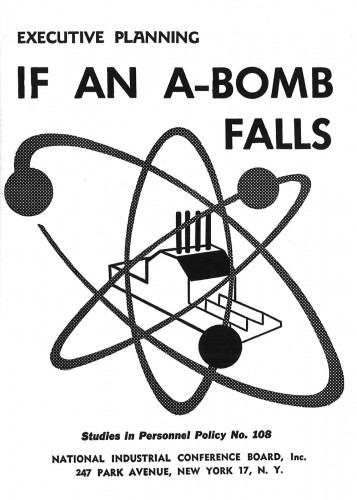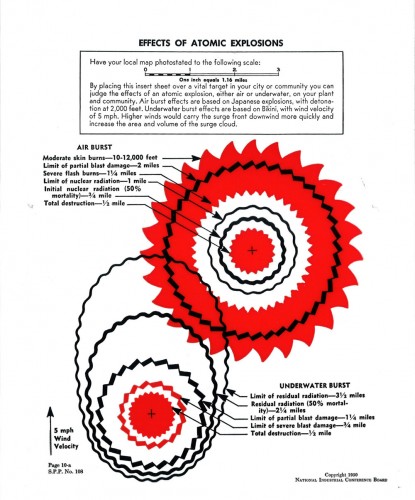John Cloud, an historian at the National Oceanic and Atmospheric Administration (NOAA), sent me scans of a really wonderful precursor to the NUKEMAP. It comes from a 1950 publication by the National Industrial Conference Board titled, If an A-Bomb Falls:
John reports that the pamphlet was some 20 pages long and was designed to help apocalypse-minded executives figure out how impending nuclear war might affect their bottom line.
The mapping connection comes from the fact that the pamphlet also included a overlay acetate sheet that, if you had your maps printed to the right size, could be overlaid on top of them to show you various nuclear effects:
As the overlay explains,
By placing this insert over a vital target in your community you can judge the effects of an atomic explosion, either air or underwater, on your plant and community. Air burst effects are based on Japanese explosions, with detonation at 2,000 feet. Underwater burst effects are based on Bikini, with wind velocity of 5 mph. Higher winds would carry the surge front downwind more quickly and increase the area and volume of the surge cloud.
The radii don’t quite match up to the NUKEMAP calculations, but they’re close. They’re a bit larger on the whole because they include some more moderate effects, like “moderate skin burns.” It’s also probably the case that even in 1950, the AEC hadn’t released full information on the effects radii. But other than that, they seem to match up well with 20kt explosions.
Of course, by 1950, the US had already increased its standard yields to around 49kt. And the yields would only go up from there. The Soviets had 20kt bombs in 1950, but by 1951 would be testing weapons in the 40kt range. And the yields would only go up from there. (And so it goes.) So this sort of overlay would have had, let us say, some planned obsolescence built into it.
Still, it’s pretty amazing, with its brilliant colors and highly “busy” rings. No simple circles here!
For your amusement, I whipped up a very simple Google Maps simulation of what it would be like to use ones of these. Nothing fancy — just drag your location and the “air burst” image will remain centered (and at the right size for a 20kt blast):
John (who is known to historians of Cold War secrecy as the author of a number of articles on the CORONA satellites) came across this in the Coast and Geodetic Survey Library during his long-running research into the origins and practices of analog map overlays, the genesis of what are now called geographic information systems. Pretty interesting stuff.




oh my god
[…] post to the other simulators out there. Frankly, even those are just the latest iterations in a pretty old genre. I’m not claiming to have re-invented the wheel here, and I’ve been as surprised as you […]
That gave me quite a jolt! My location is less than a mile from a facility which was certainly a store for naval ammo during the Falklands conflict, and has the reputation locally of having been (if not still being) used for storage of ICBM warheads. Your simulation put ground zero about a quarter of a mile away from the central point of this facility!